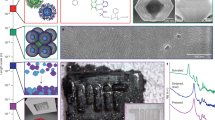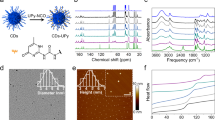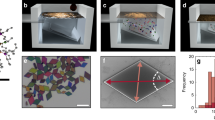Abstract
Multi-scale ordering of materials is central for the application of molecular systems1,2,3 in macroscopic devices4,5. Self-assembly based on selective control of non-covalent interactions6,7,8 provides a powerful tool for the creation of structured systems at a molecular level, and application of this methodology to macromolecular systems provides a means for extending such structures to macroscopic length scale9,10,11. Monolayer-functionalized nanoparticles can be made with a wide variety of metallic and non-metallic cores, providing a versatile building block for such approaches. Here we present a polymer-mediated ‘bricks and mortar’ strategy for the ordering of nanoparticles into structured assemblies. This methodology allows monolayer-protected gold particles to self-assemble into structured aggregates while thermally controlling their size and morphology. Using 2-nm gold particles as building blocks, we show that spherical aggregates of size 97 ± 17 nm can be produced at 23 °C, and that 0.5–1 µm spherical assemblies with (5–40) × 105 individual subunits form at -20 °C. Intriguingly, extended networks of ∼50-nm subunits are formed at 10 °C, illustrating the potential of our approach for the formation of diverse structural motifs such as wires and rods. These findings demonstrate that the assembly process provides control over the resulting aggregates, while the modularity of the ‘bricks and mortar’ approach allows combinatorial control over the constituents, providing a versatile route to new materials systems.
This is a preview of subscription content, access via your institution
Access options
Subscribe to this journal
Receive 51 print issues and online access
$199.00 per year
only $3.90 per issue
Buy this article
- Purchase on Springer Link
- Instant access to full article PDF
Prices may be subject to local taxes which are calculated during checkout





Similar content being viewed by others
References
Anelli,P. L., Spencer,N. & Stoddart, J. F. A molecular shuttle. J. Am. Chem. Soc. 113, 5131–5133 ( 1991).
Otsuki,J. et al. Redox-responsive molecular switch for intramolecular energy transfer. J. Am. Chem. Soc. 119, 7895– 7896 (1997).
de Silva,A. P., Gunaratne,H. Q. N. & McCoy, C. P. Molecular photoionic and logic gates with bright fluorescence and “off-on” digital action. J. Am. Chem. Soc. 119, 7891–7892 ( 1997).
Alivisatos,A. P. From molecules to materials: Current trends and future directions. Adv. Mater. 10, 1297–1336 (1998).
Breen,T. L., Tien,J., Oliver,S. R. J., Hadzic,T. & Whitesides, G. M. Design and self-assembly of open, regular, 3D mesostructures. Science 284, 948–951 (1999).
Lehn,J.-M. Supramolecular Chemistry (VCH, Weinheim, 1995).
Fyfe,M. C. T. & Stoddart,J. F. Synthetic supramolecular chemistry. Acc. Chem. Res. 30, 393– 401 (1997).
Rebek,J. Reversible encapsulation and its consequences in solution. Acc. Chem. Res. 32, 278–286 ( 1999).
Stupp,S. I. et al. Supramolecular materials: Self-organized nanostructures. Science 276, 384–389 ( 1997).
Kotera,M., Lehn,J. -M. & Vigneron, J. -P. Self-assembled supramolecular rigid rods. J. Chem. Soc. Chem. Commun. 197–199 (1994).
Edgecombe,B. D., Stein,J. A., Fréchet, J. M. J., Xu,Z. & Kramer,E. J. The role of polymer architecture in strengthening polymer-polymer interfaces: A comparison of graft, block, and random copolymers containing hydrogen-bonding moieties. Macromolecules 31, 1292–1304 ( 1998).
Andres,R. P. et al. Self-assembly of a two-dimensional superlattice of molecularly linked metal clusters. Science 273, 1690 –1693 (1996).
Markovich,G. et al. Architectonic quantum dot solids. Acc. Chem. Res. 32, 415–423 ( 1999).
Liu,J. et al. Cyclodextrin-modified gold nanospheres. Host-guest interactions at work to control colloidal properties. J. Am. Chem. Soc. 121, 4304–4305 (1999).
Marinakos,S. M., Brousseau,L. C. III, Jones,A. & Feldheim,D. L. Template synthesis of one-dimensional Au, Au-poly(pyrrole), and poly(pyrrole) nanoparticle arrays. Chem. Mater. 10, 1214 –1219 (1998).
Whetten,R. L. et al. Crystal structures of molecular gold nanocrystal arrays. Acc. Chem. Res. 32, 397–406 (1999).
Mucic,R. C., Storhoff,J. J., Mirkin,C. A. & Letsinger,R. L. DNA-directed synthesis of binary nanoparticle network materials. J. Am. Chem. Soc. 120, 12674–12675 (1998).
Mirkin,C. A., Letsinger,R. L., Mucic,R. C. & Storhoff,J. J. A DNA-based method for rationally assembling nanoparticles into macroscopic materials. Nature 382, 607– 609 (1996).
Alivisatos,A. P. et al. Organization of ‘nanocrystal molecules’ using DNA. Nature 382, 609–611 (1996).
Boal,A. K. & Rotello,V. M. Redox-modulated recognition of flavin by functionalized gold nanoparticles. J. Am. Chem. Soc. 121, 4914–4915 ( 1999).
Deans,R., Ilhan,F. & Rotello,V. M. Recognition mediated unfolding of a self-assembled polymeric globule. Macromolecules 32, 4956– 4960 (1999).
Park,T. K., Schroeder,J. & Rebek, J. New molecular complements to imides. Complexation to thymine derrivatives. J. Am. Chem. Soc. 113, 5125–5127 (1991).
Muehldorf,A. V., Van Engen,D., Warner,J. C. & Hamilton,A. D. Aromatic aromatic interactions in molecular recognition: a family of artificial receptors for thymine that shows both face-to-face and edge-to-face interactions. J. Am. Chem. Soc. 110, 6561– 6562 (1988).
Brust,M., Walker,M., Bethell,D., Schiffrin,D. J. & Whyman, R. Synthesis of thiol-derivatized gold nanoparticles in a 2-phase liquid-liquid system. J. Chem. Soc. Chem. Commun. 801–802 (1994).
Ingram,R. S., Hostetler,M. J. & Murray, R. W. Poly-hetero-omega-functionalized alkanethiolate-stabilized gold cluster compounds. J. Am. Chem. Soc. 119, 9175–9178 (1997).
Acknowledgements
This work was supported by the NSF. V.M.R. also acknowledges support from the Petroleum Research Fund of the ACS, the Center for University Research in Polymers at the University of Massachusetts, the Alfred P. Sloan Foundation, Research Corporation, and the Camille and Henry Dreyfus Foundation.
Author information
Authors and Affiliations
Corresponding author
Rights and permissions
About this article
Cite this article
Boal, A., Ilhan, F., DeRouchey, J. et al. Self-assembly of nanoparticles into structured spherical and network aggregates. Nature 404, 746–748 (2000). https://doi.org/10.1038/35008037
Received:
Accepted:
Issue Date:
DOI: https://doi.org/10.1038/35008037
This article is cited by
-
Magnetisation reversal in two-dimensional ensemble of nanoparticles with positional defects
Pramana (2023)
-
Experimental and Theoretical Investigation for Synthetic Polymers, Biopolymers and Polymeric Nanocomposites Application in Enhanced Oil Recovery Operations
Arabian Journal for Science and Engineering (2022)
-
Aerogels: promising nanostructured materials for energy conversion and storage applications
Materials for Renewable and Sustainable Energy (2020)
-
Improved small-angle x-ray scattering of nanoparticle self-assembly using a cell with a flat liquid surface
Journal of Nanoparticle Research (2019)
-
EDC-Induced Self-Assembly of BSA-Au NCs
Journal of Fluorescence (2019)
Comments
By submitting a comment you agree to abide by our Terms and Community Guidelines. If you find something abusive or that does not comply with our terms or guidelines please flag it as inappropriate.



